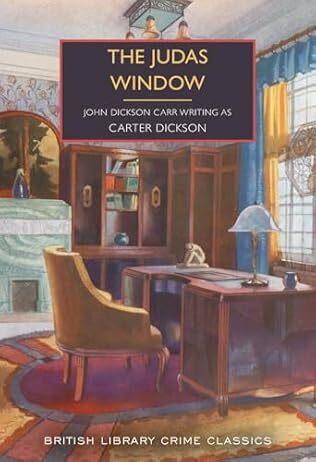The Judas Window

A review of The Judas Window by Carter Dickson – 250814
Also known as The Crossbow Murder and first published in 1938, The Judas Window is widely regarded as being one of the most famous and highly respected locked room mysteries from the pen of the master of the subgenre John Dickson Carr, who also wrote under the pseudonym of Carter Dickson . It is the seventh story featuring Sir Henry Merrivale (HM) and is a welcome addition to the impressive British Library Crime Classics series.
The book falls into three parts, a prologue entitled What Might Have Happened, the much longer section set mainly at the Old Bailey entitled What Seemed To Happen, and an epilogue, What Really Happened. The middle section, narrated by Ken Blake, who with his wife, Evelyn, are friends of HM, is by far the longest and follows broadly the progress of the trial of Jimmy Answell, accused of the murder of Avory Hume. HM, making his first appearance as a silk in fifteen years, seems to have picked a forlorn case to make his return to world of forensic oratory as the facts of the case seem to tell only one story.
After a whirlwind romance Jimmy has become engaged to Mary Hume, Avory’s daughter, and is visiting London to visit his prospective father-in-law at the latter’s house at 12, Grosvenor Street, a house at which also Dr Spencer Hume, Hume’s brother, the housekeeper, Amelia Jordan, and the butler, Dyer, also live. Jimmy is apprehensive and is surprised to find the study in which the interview takes place has its heavy shutters closed. Hume, a keen toxophilist, has a trophy consisting of a triangle constructed from three arrows hanging on the wall.
Answell drinks a glass of whisky, loses consciousness and when he wakes up, he finds that Hume is dead with an arrow protruding from his chest. The door is bolted, the shutters closed, and Answell’s fingerprints are on the arrow that has been used as a murder weapon. Dyer, Spencer Hume, and Mary Hume break into the room and when they summon the police, there can only be one conclusion. No decanter, let alone doctored whisky, is found in the room and Answell has no signs of being poisoned or drugged.
I am not normally a great fan of court room dramas, but Carter Dickson makes this one very engaging. There is real doubt as to the way the verdict will go until almost the very end and in the exchanges between witnesses and counsel and the commentary between Blake and Merrivale as the case proceeds we learn much about the key characters in the story. To spice things up there is a spot of blackmail arising from an indiscretion on the part of Mary Hume, a scheme to exact revenge, the convenient but unfortunate homophony of two key names, a convenient hint of insanity in the family and an absconding witness, all of which help Merrivale to chip away at the mass of circumstantial evidence that points conclusively to Answell’s guilt.
HM seems fixated on trivia such as an ink pad, a golfing suit, a piece of blue feather from the arrow, a suitcase, and, perhaps most importantly of all, a Judas window. The latter, HM avers almost from the start, holds the key to how the murder was committed and of Answell’s innocence. He shocks everyone by stating that every room has a Judas window – you just have to know where to find it. Perhaps the greatest aid the reader has for solving the mystery are the detailed annotated timetables of events that HM produces, a careful study of which leads to the inevitable realization that only one person could have committed the murder in the time available.
With such an intriguing set up, the solution has to be ingenious and, my word, it is, although it is no rabbit pulled out of a hat. Slowly but surely HM assembles all the pieces through his forensic arguments and interrogation of the witnesses until they produce a cogent, coherent and compelling answer to the question if it was not Answell, who was it and how was it pulled off. It is a tour de force and as is often the way the most unlikely is often the likeliest.



